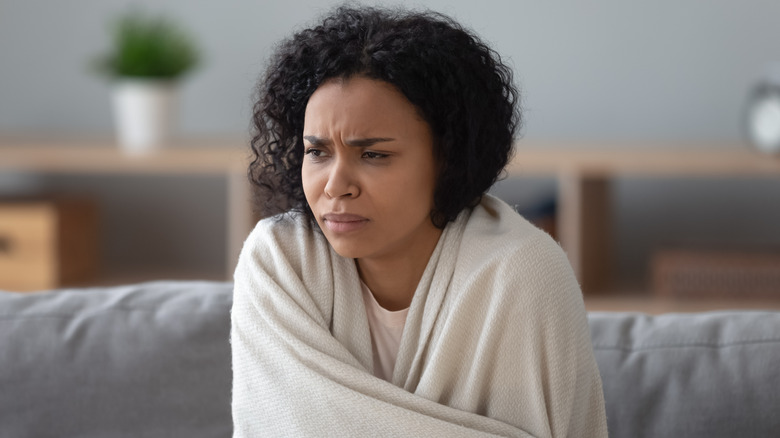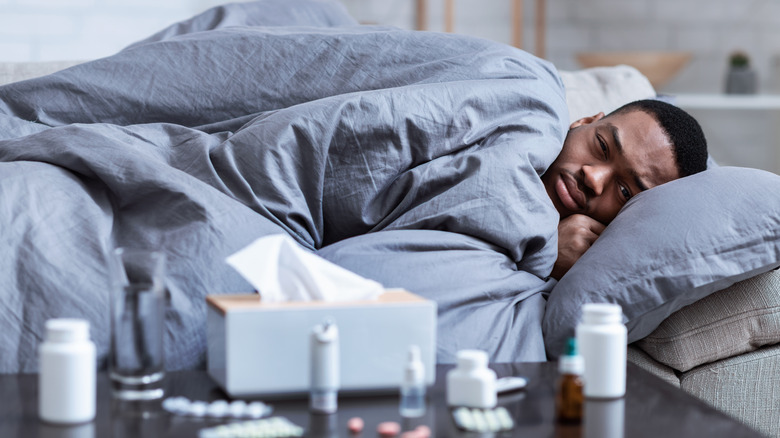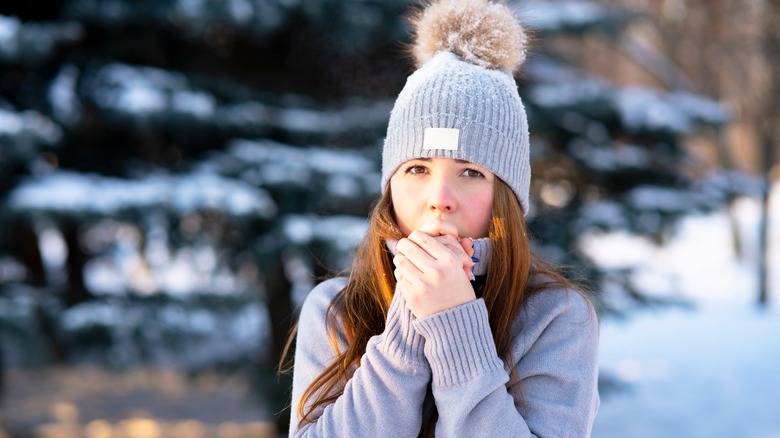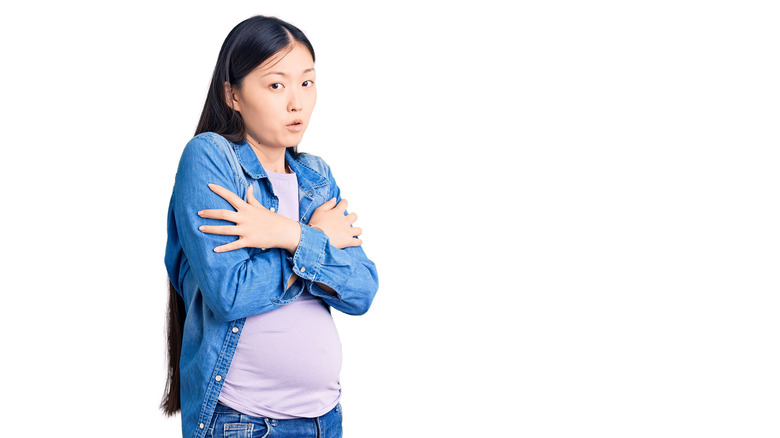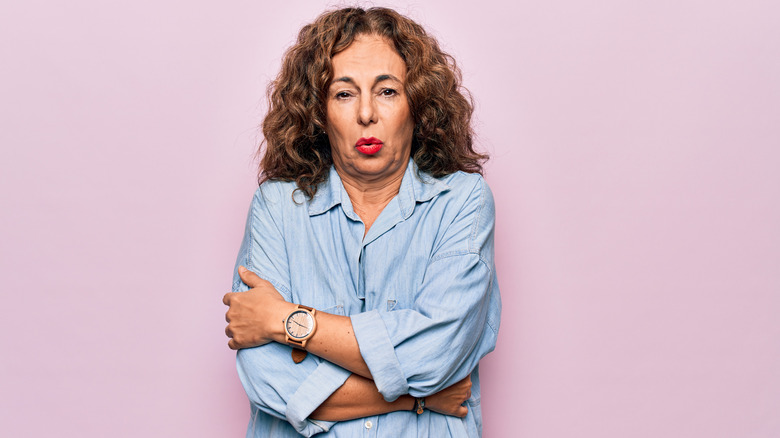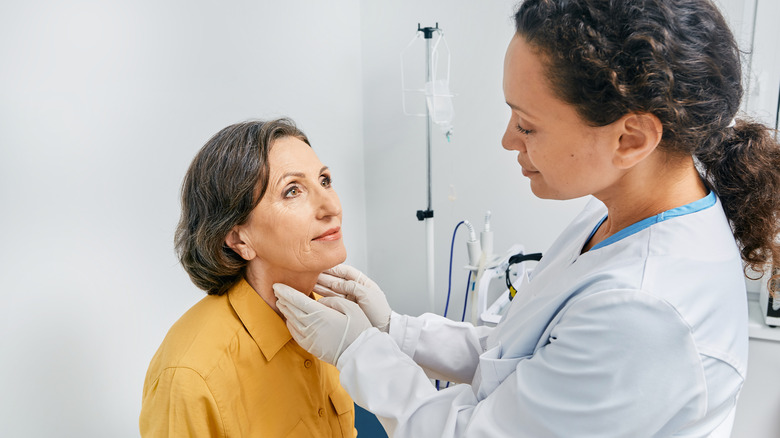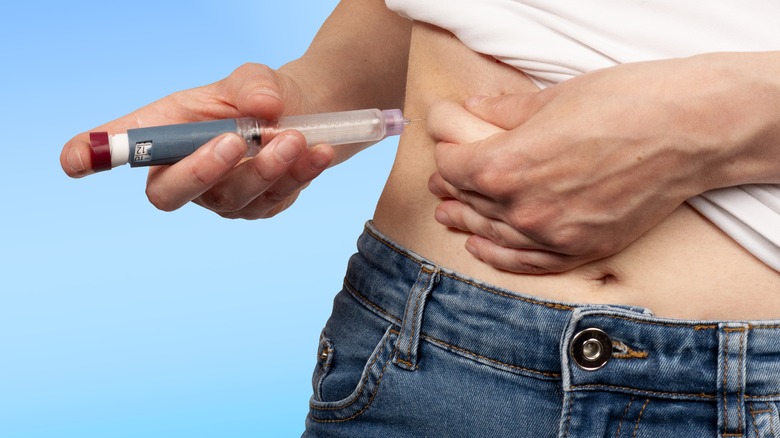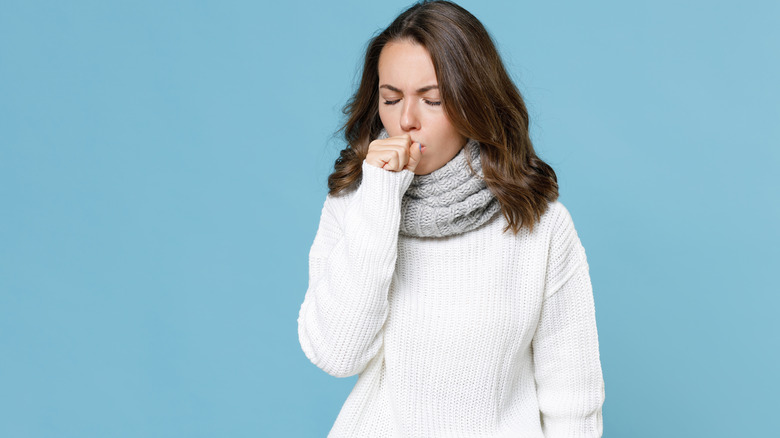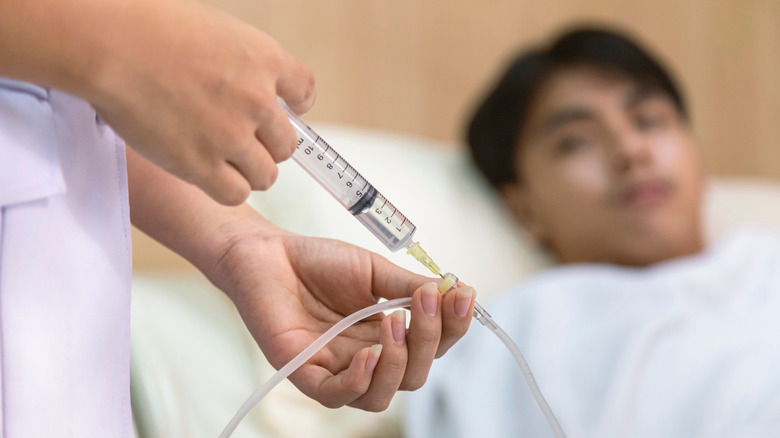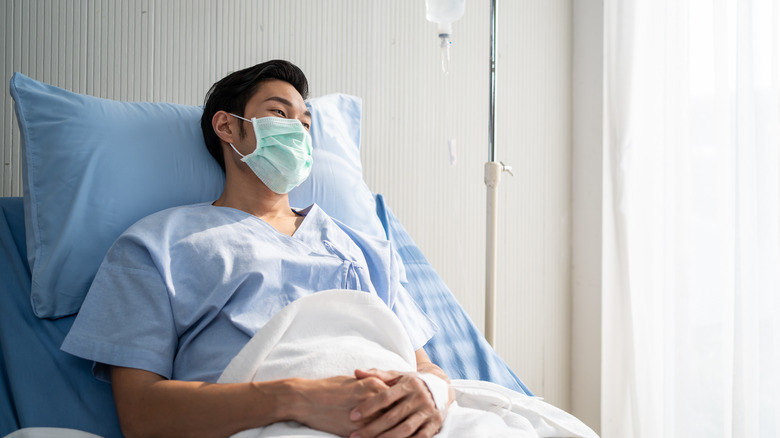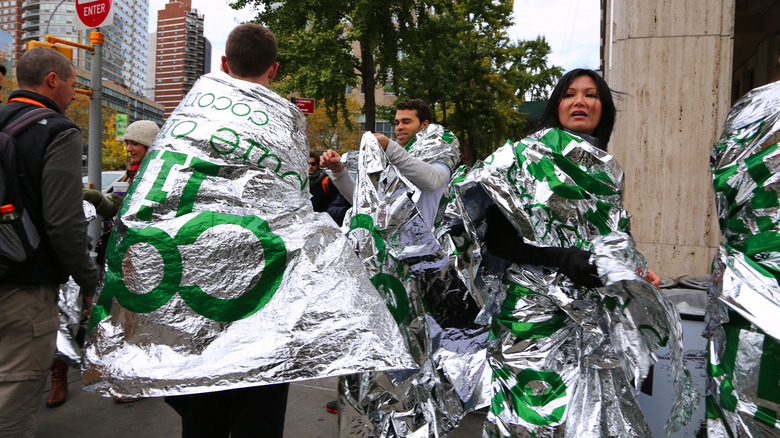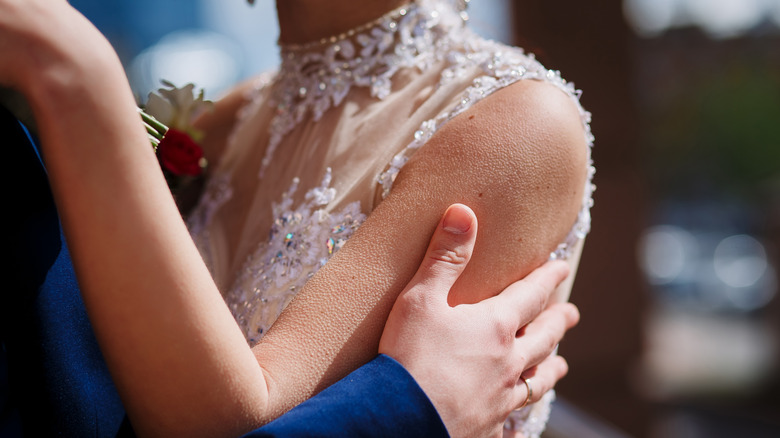What It Really Means When You Get Chills Without A Fever
Feeling chilly is perfectly normal in a chilly environment. A case of the chills is something different, however, according to JAMA Network, which describes a chill as a sensation of coldness that may involve anything from "tremulous" feelings to full-on shivering. Chills commonly accompany fever, per Medical News Today, with chills frequently occurring first. The reason is that when the body is under attack and the hypothalamus gland, which regulates body temperature, recognizes that the source of the attack is one that may not be able to survive at higher-than-normal body temperatures (an infection, for example), the hypothalamus directs the muscles to start contracting in an effort to raise the body temperature. These muscle contractions take the form of shivering, according to Physiology, Fever.
Accordingly, one reason you might have chills without fever is that the fever is coming; it simply hasn't happened yet, per GSK Health Partner. On the other hand, just because you have chills doesn't necessarily mean that you have or will develop a fever. Indeed, chills without fever have many possible causes, some of which don't even involve being sick, per Healthline. Here are the ones you should be on the lookout for.
Infections may cause chills without fever
Some infections may present first with chills, with fever coming only later. But some infections may cause chills without fever at all, according to Dr. Jeffrey Quinlan of the University of Iowa's medical school (via Men's Health). This is particularly true in the case of viral infections, which Dr. Andrej A. Romanovsky, an Arizona State University professor, says can "act directly on your nervous system and indirectly influence it through protein molecules that tell neural cells that your body temperature is too low," with the result being that you start shivering and feeling chills. An example of this is COVID-19, which in its current but ever-changing form is known for causing cold symptoms, gastrointestinal woes, and, now, chills without fever.
Chills without fever are less common in bacterial infections. However, two in particular may present with chills alone, and no fever. The first is bacterial meningitis, whose other symptoms include "stiff neck, sensitivity to light and sound, and lethargy," according to Dr. Quinlan, who advises that these symptoms merit a visit to the ER. The other is malaria, which can lead to alternating cold and hot flashes, with or without fever. The Centers for Disease Control and Prevention (CDC) website lists countries where malaria is prevalent, so if you've traveled to any and are now experiencing extreme temperature fluctuations and flu-like symptoms, it might be worth a chat with your internist.
Being in a cold environment causes chills, no fever required
If you have chills but aren't running a fever, there's a good chance your body is reacting to being in an environment that's colder than comfortable — perhaps unsurprisingly, according to Medical News Today, environmental cold is the most common reason for chills without fever. As with chills that precede fever, your hypothalamus is telling your muscles to generate heat by shivering, with the goal being to raise the core body temperature.
If you're shivering in response to a cold environment, it would be wise to regard your chills as an unequivocal demand from your body to either get someplace warmer as soon as possible or throw on some layers. Chills with shivering is an early sign of hypothermia, per Hypothermia, and it's also the one that is most likely to be obvious to you, especially if you're outside alone. Other early symptoms of hypothermia — fatigue, nausea, hunger, rapid heart rate, and pale-dry skin — can seem a bit more ambiguous.
Paying attention to your shivering and taking action to increase your body heat is critical when you're outside in the elements because shivering actually ceases long before the body temperature drops below the clinical definition of "mild hypothermia," which is when body temperature falls to 86 degrees Fahrenheit and below (via Hypothermia).
Chills without fever can be an early pregnancy sign
Those familiar with basal body temperature method for predicting optimal times for conception (or the opposite) may already be familiar with body temperature fluctuations that occur at predictable times during the menstrual cycle. This is a response to fluctuating hormones, per Planned Parenthood. At ovulation, the body temperature rises in response to the release of progesterone. If no fertilization occurs, body temperature falls as menstruation begins, according to Physiology, Ovulation And Basal Body Temperature Physiology. If fertilization does occur, body temperature remains in this not-a-fever-but-higher-than-normal-range, which may lead to chills, according to OB/GYN Alan Lindemann (per Romper).
This increase in body temperature may last for weeks, according to MomLovesBest, and it may produce flu-y feelings. But if you do experience an actual fever while pregnant (a core temperature of over 100 F, per What to Expect), it might indicate an infection or other condition, which your doctor can help you sort out and treat, per Ovia Health. If your chills don't seem to abate after the first trimester, that may also indicate that something else is going on.
The hormonal changes associated with menopause may trigger chills
Menopause begins 12 months after one's last menstrual period (via National Institutes on Aging). The average age at which a woman goes through menopause is 51, but it can happen earlier if a woman's ovaries are surgically removed, or sometimes for no discernible reason menopause arrives in one's 30s or 40s. The hormonal changes that occur in the months and years immediately before and after menopause begins produce the symptoms that most people associate with menopause, including hot flashes — moments of intense internal heat lasting from 30 seconds to a few minutes (per Johns Hopkins Medicine).
But hot flashes are not the only temperature fluctuations that can come with menopause. The hormonal changes happening during the period surrounding the onset of menopause can also cause brief periods of chills and shivering, according to Healthline. Sometimes these "cold flashes," as they are sometimes called, occur as an isolated event. But sometimes they are the closing act for a hot flash. In all cases, cold flashes are a function of the effects of hormonal fluctuations on the activity of the hypothalamus, which regulates body heat (via 2017 paper published in Scientific Reports). If you're not yet in menopause and you've been experiencing increasing menstrual irregularity, mood swings, weight gain, vaginal dryness, and/or thinning hair, your cold flashes could be a sign that you're in those years preceding menopause, i.e. perimenopause.
Hypothyroidism can cause chills without fever
The thyroid is a small, butterfly-shaped gland in the throat that produces and circulates certain hormones throughout the body to regulate metabolism — i.e., the process of converting what you consume into energy, per the Cleveland Clinic. When the production of thyroid hormone is impaired — or, in rarer cases, if something is interfering with the transport and/or registering of presence of thyroid hormone throughout the body — hypothyroidism may be diagnosed.
In hypothyroidism, the metabolism is slower than it should be. When the metabolism slows, a number of symptoms may present, including a drop in core body temperature, according to Medical News Today. This in and of itself is enough to cause chills, and since the hypothalamus gland kicks in when it perceives that body temperature is lower than optimal, it may send a message to your muscles to commence shivering, per Physiology, Fever. Chills in connection with low thyroid or low thyroid sensitivity may have the effect of making one feel cold even in a warm environment.
Fever need not be present, nor do the chills necessarily bring on a fever in hypothyroidism. However, in some forms of hypothyroidism, such as subacute thyroiditis, which starts as thyroid inflammation that then leads to impaired manufacture and release of thyroid hormone, low-grade fever is a symptom (via Merck Manuals Consumer Version).
Chills in the absence of fever could be a sign of low blood sugar
Another possible cause of chills without fever is hypoglycemia, or low blood sugar, per Healthline. Related symptoms of low blood sugar may include sweating and clammy skin. Low blood sugar can also temporarily impair coordination and/or cause a sensation of tingling or numbness of the mouth. In addition, it may present with blurry vision, headache, and confusion. As hypoglycemia worsens or continues without treatment, it can lead to seizure and even loss of consciousness. But for these symptoms to present as a result of hypoglycemia, blood sugar levels would have to be significantly lower than what is considered normal.
For individuals without a diabetes diagnosis, blood sugar generally remains at a fairly stable level — between 70 and 100 milligrams per deciliter (mg/dL), even in the face of actual hunger (as opposed to "hunger" caused by cravings), per MedicineNet and WebMD. In fact, chills and the other aforementioned symptoms of low blood sugar tend to present when blood sugar levels hit well below 70. So, those at risk for clinical hypoglycemia are primarily those with metabolic disorders affecting the metabolism of sugar (i.e., diabetes), especially those taking insulin, which is known to trigger hypoglycemia when more is taken than what the body needs at any given moment (via American Diabetes Association).
Iron-deficiency anemia may produce chills without fever
Just as low blood sugar may cause chills without fever, so too may shortages of other nutrients. For example, an iron deficiency may cause chills even if no fever is present (via Cleveland Clinic). The blood needs iron to make hemoglobin, a protein in red blood cells that carries incoming oxygen from the lungs to all other body parts, according to Harvard T.H. Chan School of Public Health. Iron is also necessary to make myoglobin, which transports and stores oxygen throughout the muscles of the body. When the blood is iron-poor, it's known as iron-deficiency anemia, a symptom of which is chills, as well as pallor and fatigue. In some cases, depression may occur as a sequala of iron-deficiency anemia, per Psych Central.
Iron deficiency anemia may be the direct result of inadequate nutrition. It may also be connected to certain medications and chronic illnesses. Additionally, menstruation may deplete the body of iron-rich blood (via Mayo Clinic). If you're feeling chills and any other symptoms of iron deficiency anemia, a blood test can confirm or rule it out. Treatment may be as simple as iron supplementation or, in more serious cases, transfusion. A vitamin B-12 deficiency may also be behind iron-deficiency anemia, according to WebMD, because vitamin B12 is crucial for the formation of healthy blood cells (via National Heart Lung and Blood Institute).
Chills can be a sign of poor circulation
Impaired circulation may cause chills that start in the extremities, according to the Cleveland Clinic. Poor circulation has many causes, including smoking, high blood pressure, and atherosclerosis. The last refers to a narrowing of arteries due to buildup of intraarterial plaque. Plaque is often associated high blood cholesterol levels, according to the American Heart Association. In addition, a condition known as peripheral artery disease, whose causes include smoking, high blood pressure, and atherosclerosis, may cause poor circulation beginning in the arteries leading from the arms, legs, fingers, and toes to the heart, according to the Cleveland Clinic. However, because your circulatory system connects all your bodily systems, the damage associated with peripheral artery disease may extend to arteries and tissue well beyond the extremities.
As scary as it might seem to experience signs of poor circulation, there's also a bright side. Since some of the aforementioned causes of poor circulation are known to present without symptoms, per Mayo Clinic and Medical News Today, feverless chills accompanied by tingling in the extremities may be your first and only clue that your circulatory system is not functioning up to par and that you should make an appointment with your doctor. When circulation is compromised, the medical consequences can be serious, ranging from tissue death (and potential amputation) to organ failure to death from stroke or heart attack, among others, according to the American Heart Association.
Chills can be a sign of heart attack
Not to scare you, but chills may also be a sign that you're actually experiencing a heart attack, according to the Heart Foundation, which states that "sweating, or breaking out in a cold sweat — that is, a sudden chill in your body, regardless of temperature in the environment" is one of the most common warning signs of heart attack to be aware of. The others include lightheadedness, nausea and indigestion that may be accompanied by vomiting, and a feeling of shortness of breath. In addition, a heart attack could present with no symptoms. However, if you feel a sudden chill that has no obvious cause, and it continues for more than 10 minutes, that could indicate heart attack, especially if you're at risk.
Some things that put you at risk of heart attack aren't within your control — these include being age 65 or old, being male, and having a parent with heart disease, according to American Heart Association. Things that put you at risk that you can control include smoking, high cholesterol, high blood pressure, physical inactivity, obesity, diabetes, excessive alcohol use, unmanaged stress, and poor diet.
Chills can come on from being hooked up to an IV
Something they may not tell you when you're about to be hooked up to an IV is that you may experience chills, including uncontrollable shivering. And this can occur in the absence of fever and even if the treatment room is warm, according to a 2013 study published in the West Journal of Emergency Medicine. A nursing information site maintained by Brookside Associates offers two primary reasons. One is known as "speed shock" or "circulatory overload." In this case, chills and shivering occur when "too much fluid and/or too much medication is administered too rapidly." Apparently, this can happen even if the medical team has done everything exactly according to protocol. Other symptoms of circulatory overload include headache, flushing, irregular pulse, and labored breathing.
Another cause of chills during an IV infusion include contamination of the IV with a pathogen, which unfortunately can happen on occasion, often within the first 30 minutes after the infusion has started, but sometimes not for two to three days. When an IV has transmitted an infection, chills, nausea, vomiting, and backache tend to present first, often culminating in a sudden fever. According to the 2013 study referenced above, however, sometimes an IV causes chills and shivering for no reason other than that the IV fluids have not been warmed to body temperature prior to administration.
Chills may set in as you awaken from general anesthesia
If you've ever had general anesthesia, there is a two in three chance you've experienced that strange sensation of rather severe chills upon waking up, according to the Cleveland Clinic. As the Cleveland Clinic notes, even if you aren't necessarily feeling cold, you may still find yourself shivering seemingly uncontrollably or for no clear reason. However, there is a cause behind shivering after general anesthesia.
"The induction and maintenance of general anesthesia will, in its own right, lead to a drop in the patient's core temperature," according to a 2017 paper published in the journal Temperature (Austin). In addition, the paper goes on to say that body heat is also lost while anesthesia is on board due to environmental factors, including a chilly operating room and duration of the surgery (longer surgeries are more strongly associated with post-anesthesia shivering). As the anesthesia wears off, the hypothalamus kicks back into gear to warm the body up as efficiently as possible, and one of the ways that it does so is to cause the muscles to rapidly contract in what laypeople recognize as shivering, per the Cleveland Clinic.
Engaging in strenuous physical activity can lead to the chills
If you've ever found yourself shivering after finishing a workout, particularly a strenuous one, it's actually quite normal, according to Dr. Ollie Jay of the University of Ottowa, speaking to Outside Online. When you start working out, Dr. Jay explains, your metabolic rate rises to support your circulatory system's delivery of oxygen to your muscles so that they can contract as needed for whatever activity you're doing. It continues like that for around 30 to 45 minutes, at which point your body begins to lose heat through your skin, thanks in part to increased blood flow to the skin.
As soon as you're finished with your workout, your metabolic rate will start to slow down, but you'll keep sweating and losing heat through your skin. For some people, this has the effect of causing them to shiver and/or feel a sensation of coldness. This phenomenon is more common among women and men who are long and lanky, because they all tend to have a "high surface area to mass ratio," according to Jay.
Hangovers can cause chills without fever
There are two main reasons why chills and shivering may occur with a hangover, according to Heroes' Mile. The first starts with the notion that while a hangover is distinct from alcohol withdrawal, the two conditions share features, including chills, nausea, headache, sweating, tremors, rapid heartbeat and pulse, and elevated blood pressure. In the case of a hangover, chills may reflect that after a night of drinking, your nervous system has not yet readjusted to having zero alcohol in your system.
The second reason has to do with how your immune system responds to having been exposed to alcohol in the first place. Alcohol exposure can trigger the immune system to release cytokines. Cytokines play an important role in normal immune responses, according to the National Cancer Institute. However, at higher levels, they're associated with chills, as well as nausea, headache, and fatigue.
Your emotions can cause chills without fever
In the absence of fever or any of the physical stimuli we've been discussing here, emotions can trigger chills. In fact, a 2009 review published in the Annals of the New York Academy of Science found that chills, particularly those that produce goosebumps (which occur because the hair follicles at the surface of your skin are drawn up into tiny peaks by the hairs standing on end), can reliably indicate emotional peaks. That particular study focused solely on what appear to be positive emotional reactions to music. But music is just one source of emotional stimulus that may produce chills, and not all chills are associated with positive emotions.
A 2019 study published in PLOS ONE set out to identify other kinds of emotional chills — those that occur in response to a variety of stimuli and that reflect a spectrum of emotional responses. Analyzing the response of 179 people to "images, videos, music videos, texts and music excerpts (from both an online forum dedicated to chills-eliciting stimuli and previous musical chills study)," the scientists identified three categories of chills. Warm chills are those that co-occur with pleasant feelings. Cold chills are those that co-occur with sad or angry feelings. Moving chills are like warm chills and cold chills, but are associated with greater intensity — i.e., feeling emotionally "moved." Chills may also be one of the sequelae of anxiety or fear, according to Psych Central.

